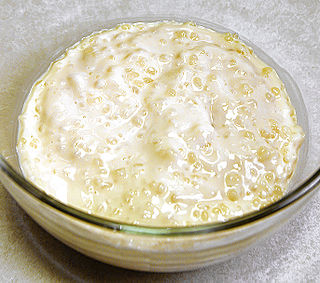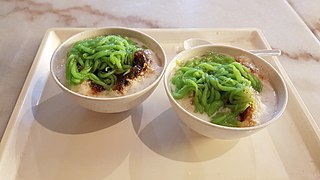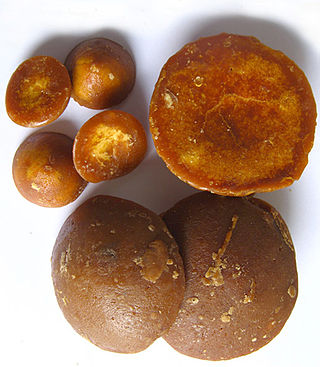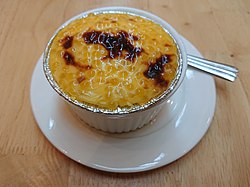
Tapioca is a starch extracted from the tubers of the cassava plant, a species native to the North and Northeast regions of Brazil, but whose use is now spread throughout South America. It is a perennial shrub adapted to the hot conditions of tropical lowlands. Cassava copes better with poor soils than many other food plants.

Sago is a starch extracted from the pith, or spongy core tissue, of various tropical palm stems, especially those of Metroxylon sagu. It is a major staple food for the lowland peoples of New Guinea and the Maluku Islands, where it is called saksak, rabia and sagu. The largest supply of sago comes from Southeast Asia, particularly Indonesia and Malaysia. Large quantities of sago are sent to Europe and North America for cooking purposes. It is traditionally cooked and eaten in various forms, such as rolled into balls, mixed with boiling water to form a glue-like paste (papeda), or as a pancake.

Malaysian cuisine consists of cooking traditions and practices found in Malaysia, and reflects the multi-ethnic makeup of its population. The vast majority of Malaysia's population can roughly be divided among three major ethnic groups: Malays, Chinese and Indians. The remainder consists of the indigenous peoples of Sabah and Sarawak in East Malaysia, the Orang Asli of Peninsular Malaysia, the Peranakan and Eurasian creole communities, as well as a significant number of foreign workers and expatriates.

Rice pudding is a dish made from rice mixed with water or milk and other ingredients such as cinnamon, vanilla, and raisins.

Tapioca pudding is a sweet pudding made with tapioca and either milk or cream. Coconut milk is also used in cases in which the flavour is preferred or in areas in which it is a commonplace ingredient for cooking. It is made in many cultures with equally varying styles, and may be produced in a variety of ways. Its consistency ranges from thin (runny), to thick, to firm enough to eat with a fork.

Kuih are bite-sized snack or dessert foods commonly found in Southeast Asia and China. It is a fairly broad term which may include items that would be called cakes, cookies, dumplings, pudding, biscuits, or pastries in English and are usually made from rice or glutinous rice. In China, where the term originates from, kueh or koé (粿) in the Min Nan languages refers to snacks which are typically made from rice but can occasionally be made from other grains such as wheat. The term kuih is widely used in Malaysia, Brunei, and Singapore, kueh is used in Singapore and Indonesia, kue is used in Indonesia only, all three refer to sweet or savoury desserts.

Palm sugar is a sweetener derived from any variety of palm tree. Palm sugar is sometimes qualified by the type of palm, as in coconut palm sugar. While sugars from different palms may have slightly different compositions, all are processed similarly and can be used interchangeably.

Cendol is an iced sweet dessert that contains droplets of pandan-flavoured green rice flour jelly, coconut milk and palm sugar syrup. It is commonly found in Southeast Asia and is popular in Indonesia, Malaysia, Brunei, Cambodia, East Timor, Laos, Vietnam, Thailand, Singapore, and Myanmar. Next to the green jelly, additional toppings might be added, including diced jackfruit, sweetened red azuki beans, or durian.

Kue is an Indonesian bite-sized snack or dessert food. Kue is a fairly broad term in Indonesian to describe a wide variety of snacks including cakes, cookies, fritters, pies, scones, and patisserie. Kue are made from a variety of ingredients in various forms; some are steamed, fried or baked. They are popular snacks in Indonesia, which has the largest variety of kue. Because of the countries' historical colonial ties, Koeé (kue) is also popular in the Netherlands.

Coconut sugar is a palm sugar produced from the sap of the flower bud stem of the coconut palm.

Binignit is a Visayan dessert soup from the central Philippines. The dish is traditionally made with glutinous rice cooked in coconut milk with various slices of sabá bananas, taro, ube, and sweet potato, among other ingredients. It is comparable to various dessert guinataán dishes found in other regions such as bilo-bilo. Among the Visayan people, the dish is traditionally served during Good Friday of Holy Week.

A great variety of cassava-based dishes are consumed in the regions where cassava is cultivated, and the ingredient is included many national or ethnic specialities.

Clorot, celorot, cerorot, or jelurut is an Indonesian traditional sweet snack made of sweet and soft rice flour cake with coconut milk, wrapped with janur or young coconut leaf in cone shape. It is a popular traditional sweet snack commonly found in Brunei, Indonesia, and Malaysia.

Bua loi or bua loy is a Thai dessert. It consists of rice flour rolled into small balls, and cooked in coconut milk and sugar. Some Bua loi also adds sweet egg into the recipe. It was inspired by Tangyuan, a Chinese dessert that is traditionally eaten around the Lantern festival. Bua Loi also traditionally eats at the Dongzhi Festival in Thailand, which is festival for the Chinese-Thai bloodline. There are a variety of versions of Bua loi such as using food coloring instead of natural color, using soy milk instead of Coconut cream, sliced Pumpkin to add inside rice balls, et cetera. There's other type of Bua loi in other country from China, Japan, Indonesia, Myanmar, Philippines, Southern Vietnam and Malaysia. 1 cup of Bua Loy has total calories of 295.5 kilocalories, protein of 10.4 grams, carbohydrate of 6.3 grams, and fat of 25 grams.

A tapioca pearl, also known as tapioca ball, is an edible translucent sphere produced from tapioca, a starch made from the cassava root. They originated as a cheaper alternative to sago in Southeast Asian cuisine. When used as an ingredient in bubble tea, they are most commonly referred to as pearls or boba. The starch pearls are typically five to ten millimeters in diameter. By adding different ingredients, like water, sugar, or some other type of sweetener like honey, tapioca pearls can be made to vary in color and in texture. Various forms of tapioca pearls include black, flavored, popping, mini, and clear. Tapioca pearls are commonly soaked in sugar syrup to make them sweet and chewy. In teas, they are often added for their texture, with the flavor being provided by the drink itself.

Pinaltok or Bilo-bilo is a Filipino dessert made of small glutinous balls in coconut milk and sugar. Then jackfruit, saba bananas, sweet potatoes, taro, and tapioca pearls or sago are added. Bilo-bilo's origin is in Luzon, which is the northern Philippines Island. There are different recipe versions depending on what region in the Philippines it is from. Some recipes call for young coconut meat and some call for adding pandan leaves. This is usually and traditionally eaten hot while others prefer eating them cold after refrigeration.

Sarawakian cuisine is a regional cuisine of Malaysia. Like the rest of Malaysian cuisine, Sarawak food is based on staples such as rice. There is also a great variety of other ingredients and food preparations due to the influence of the state's varied geography and indigenous cultures quite distinct from the regional cuisines of the Peninsular Malaysia. Sarawak is famous for its multi-ethnic population. As the homeland of many unique communities, Sarawak has a variety of cuisines rarely found elsewhere in Malaysia. The uniqueness of Sarawak well depends on its ethnic groups. Every native group in Sarawak has their own lifestyle, traditions, cultures and also foods. Sarawak cuisine is less spicy and has a subtle in taste. It uses fresh seafood and natural herbs like turmeric, lemongrass, ginger, lime and tapioca leaves. These ingredients are not only easily available, but also add a hint of aroma, texture and freshness to the delicacies. Food is one of the most cultural identities for native groups in Sarawak with each ethnic group having their own delicacies. Among the Iban, popular foods include tubu (stems), tuak and pansuh. The Malay have bubur pedas (porridge) and kek lapis Sarawak ; the Bidayuh have asam siok and sup ponas Bidayuh. The Melanau make tebaloi, sagu and umai and the Orang Ulu are known for garam barrio, kikid (broth), tengayen, and urum giruq (pudding).

Samalamig, also known as palamig, is a collective term for various Filipino sweet chilled beverages that usually include jelly-like ingredients. They come in various flavors, and are commonly sold by street vendors as refreshments. Typical ingredients of the drinks include gulaman (agar), sago pearls, kaong, tapioca pearls, nata de coco, and coconut. They are usually anglicized as pearl coolers or pearl and jelly coolers.

In the Burmese language, the term mont translates to "snack", and refers to a wide variety of prepared foods, ranging from sweet desserts to savory food items that may be cooked by steaming, baking, frying, deep-frying, or boiling. Foods made from wheat or rice flour are generally called mont, but the term may also refer to certain varieties of noodle dishes, such as mohinga. Burmese mont are typically eaten with tea during breakfast or afternoon tea time.



















